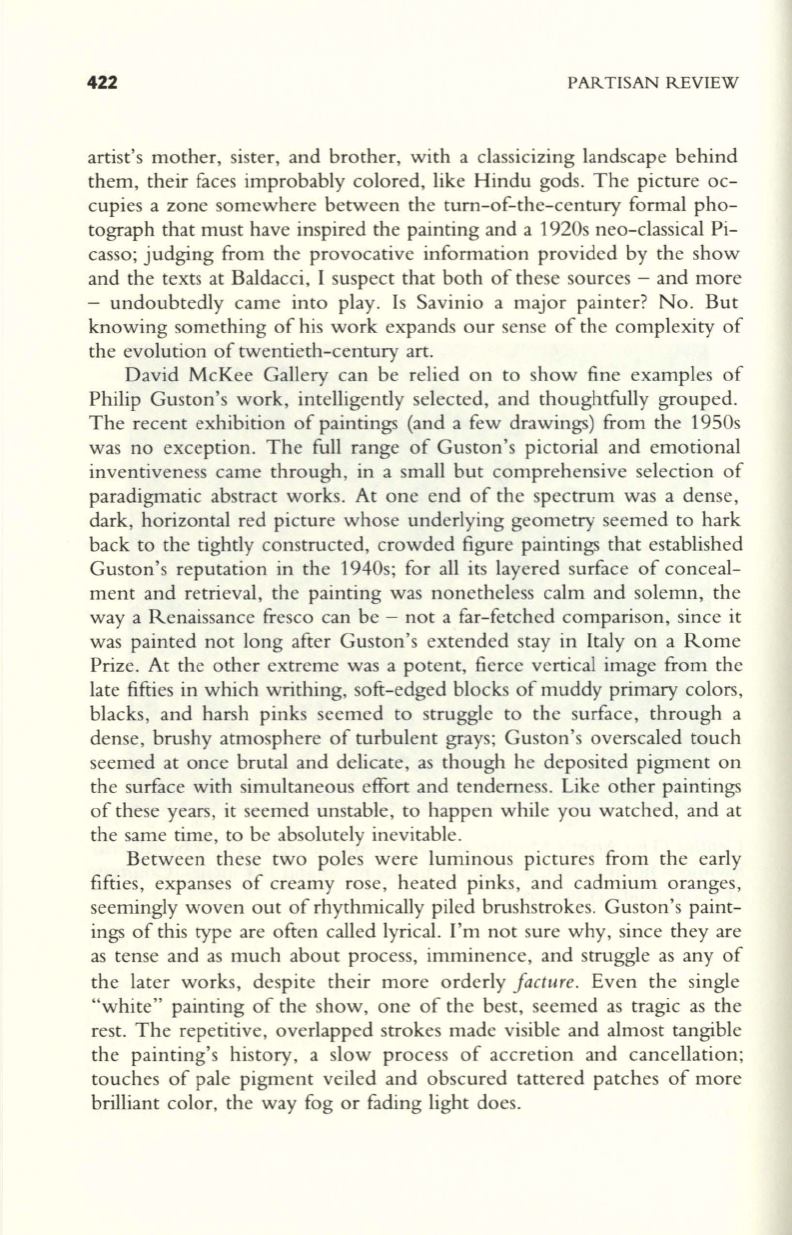
422
PARTISAN REVIEW
artist's mother, sister, and brother, with a classicizing landscape behind
them, their faces improbably colored, like Hindu gods. The picture oc–
cupies a zone somewhere between the turn-of-the-century formal pho–
tograph that must have inspired the painting and a 1920s neo-c1assical Pi–
casso; judging from the provocative information provided by the show
and the texts at Baldacci, I suspect that both of these sources - and more
- undoubtedly came into play. Is Savinio a major painter? No. But
knowing something of his work expands our sense of the complexity of
the evolution of twentieth-century art.
David McKee Gallery can be relied on to show fine examples of
Philip Guston's work, intelligently selected, and thoughtfully grouped.
The recent exhibition of paintings (and a few drawings) from the 1950s
was no exception. The full range of Guston's pictorial and emotional
inventiveness came through, in a small but comprehensive selection of
paradigmatic abstract works. At one end of the spectrum was a dense ,
dark, horizontal red picture whose underlying geometry seemed to hark
back to the tightly constructed, crowded figure paintings that established
Guston's reputation in the 1940s; for all its layered surface of conceal–
ment and retrieval, the painting was nonetheless calm and solemn, the
way a Renaissance fresco can be - not a far-fetched comparison, since it
was painted not long after Guston's extended stay in Italy on a Rome
Prize. At the other extreme was a potent, fierce vertical image from the
late fifties in which writhing, soft-edged blocks of muddy primary colors,
blacks, and harsh pinks seemed to struggle to the surface, through a
dense, brushy atmosphere of turbulent grays; Guston's overscaled touch
seemed at once brutal and delicate, as though he deposited pigment on
the surface with simultaneous effort and tenderness. Like other paintings
of these years, it seemed unstable, to happen while you watched, and at
the same time, to be absolutely inevitable .
Between these two poles were luminous pictures from the early
fifties, expanses of creamy rose, heated pinks, and cadmium oranges,
seemingly woven out of rhythmically piled brushstrokes. Guston's paint–
ings of this type are often called lyrical. I'm not sure why, since they are
as tense and as much about process, imminence, and struggle as any of
the later works, despite their more orderly
fact~lre.
Even the single
"white" painting of the show, one of the best, seemed as tragic as the
rest. The repetitive, overlapped strokes made visible and almost tangible
the painting's history, a slow process of accretion and cancellation;
touches of pale pigment veiled and obscured tattered patches of more
brilliant color, the way fog or fading light does.


